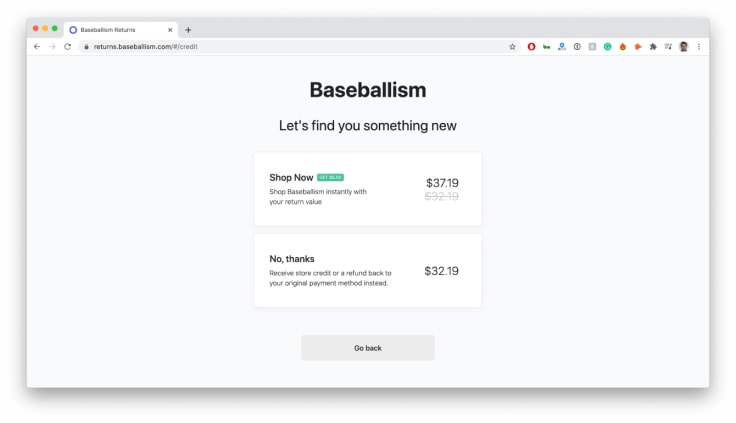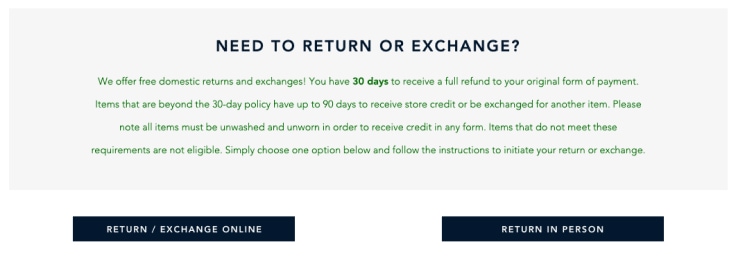We’ve all had the experience of buying a hat or a pair of pants that we love – only to receive it and realize that it’s the wrong size, color, or style.
Imagine that, as a customer, you go to start an exchange because you want the right product in your hands…only to discover that the brand doesn’t even offer exchanges.
Super frustrating, right?
Now you’re left with two options: request a refund or keep a product you’re never going to wear. Whichever path you choose, you end up dissatisfied with the outcome. This, unfortunately, is an all-too-common experience for customers.
And it stems from brands viewing returns as a cost center and assuming that all of their customers are going to want a refund. But this couldn’t be further from the truth.
Not only does a return not equal a refund, but the best e-commerce brands actually prioritize exchanges over any other type of return. In this post we are going to explain why.
Why exchanges are the king of returns
There are three types of returns that a customer can request from a brand: a refund, store credit, or an exchange. Of these three, exchanges are by far the best option. Why? Glad you asked!
Well, for one, exchanges are great because they keep the customer relationship going, which means you get to retain that revenue. This is also a great opportunity to reinforce brand loyalty since the customer had a positive experience, making it more likely that they’ll purchase additional items in the future and recommend your brand to friends and family.
All of these factors can help with your Average Order Value, Lifetime Value, and future customer acquisition efforts. Studies have also found that a 5% increase in your customer retention rate can lead to a 95% increase in profitability.
On the other hand, consider all the costs associated with a refund. Of course, you’re losing the money that the customer originally paid for their purchase. But you’re also losing the acquisition dollars that you invested to get that person in the door – not to mention the cost of shipping, labor, and the future opportunities you’re missing out on because the customer chose to end the relationship with your brand.
OK, so now you understand why exchanges are more valuable than refunds. But is it really in your control to have customers choose one or the other? The answer is yes! When you have a customer who is on the fence about whether to request an exchange or a refund, there are strategies you can implement to encourage them to opt for the exchange.
4 strategies to encourage customers to prioritize exchanges over refunds
When it comes to prioritizing exchanges over refunds, there are four effective strategies to consider. While you don’t have to implement all of these at once, try experimenting with the ones that seem most appealing or make the most sense for your brand.
Don’t charge for return shipping
Free return shipping is a big deal to customers. It’s so important that 90% of consumers highly value free returns when making online purchases – not to mention that 62% of consumers would buy again from a brand offering free returns. That’s why the first step for any brand that wants to take advantage of exchanges is to cover the cost of return shipping.
While it’s an awesome idea to offer your customers free shipping on all returns, there’s a more strategic approach you can take to encourage more exchanges: charge a small shipping fee only for refunds but not exchanges.
This subtle strategy will make customers think twice before opting for a refund. And don’t worry – you’re not going to hurt your brand reputation with this approach. Brands we have seen take this approach have seen minimal pushback.
Check out women’s apparel brand Amour Vert’s return policy as an example. A $7 shipping fee isn’t an insignificant amount of money. So if a customer is on the fence about whether to request an exchange or a refund, this fee might be enough to nudge them in the right direction.

Consider adding on a “bonus credit”
You also want to think of ways to reward customers who choose an exchange over a refund. For instance, consider giving customers a small “bonus credit” that gives them additional purchasing power above the value of what they’re returning.
For example: if a customer chooses an exchange, give them an extra $10 – it’s extra funds to shop with, which is great for the customer. But it could also potentially lead to more upsells, which is great for your business.
When paired with a shipping fee on refunds, this strategy becomes incredibly powerful. That means, if a customer wants a refund, they must turn down the $10 bonus credit and pay a shipping fee. Very few people are going to want to make that decision.
Apparel brand Baseballism uses this strategy effectively in its return portal. As you can see, the brand makes it clear that customers who choose to forgo a refund will be rewarded with an extra $5 to shop with. This “free money” can be just enough to let a customer upgrade to an even better product or splurge on another item they’ve had their eye on for a while.

Offer a generous return window
Many brands automatically default to a 30-day return window. But there’s actually very little evidence to show that this is the optimal timeframe for returns. That’s why we encourage brands to adopt a more generous return window – specifically for exchanges. So, for instance, you could offer a 15-day return window for refunds and a 90-day return window for exchanges. Or a 30-day return window for refunds and a 180-day return window for exchanges.
This applies the same logic that we mentioned before with the shipping fee strategy. All you’re doing is incentivizing more exchanges by giving customers less time to ask for a refund. Again, since a customer who wants a refund is signaling the end of the relationship anyway, this won’t harm your brand’s reputation.
If you’re worried that too long of a return window might harm your return rate, don’t be! Research at the University of Texas has actually found that a longer return window makes returns less likely.
Mizzen + Main, a men’s apparel brand, does an excellent job utilizing this strategy in its return policy. The business offers 30 days to request a refund, which is a completely fair amount of time. But for exchanges, the return window is tripled to 90 days. The message the brand is sending to customers is: we want you to get the right product in your hands and will give you as much time as you need to think it over.
Make the exchange process as easy as possible

The last thing your customer wants is to engage in multiple back-and-forth emails with your support team to initiate an exchange. Not only is it frustrating, but it’s also something that can’t be done on the customer’s own time. They can’t control when the support team responds, and they’re left with their hands tied if they want to start the exchange process outside of standard business hours.
Unfortunately, if this is the type of returns experience you offer, your customers will likely ask for a refund instead of an exchange since it’s less of a hassle they have to deal with.
To prevent this from happening to your brand, make the exchange process just as easy as the refund process. There are a few ways you can accomplish this: first, consider taking your support team out of the equation completely. You don’t need to waste their time (or the customer’s) on something as simple as an exchange.
Instead, automate your return process so that the customer can look up their own order, choose the new item that they want, and access the shipping label in a way that’s convenient for them – whether that’s a printed or mobile version. Having a process like this makes it much more likely that your customers will engage in the exchange process. Plus, 92% of consumers have stated that they’ll buy something again if returns are easy.
Check out the return portal that Allbirds uses to streamline the process. All the customer has to do is provide the order number and shipping zip code to start the exchange process. It’s easy, clear, and hassle-free.

There’s a reason why the best online brands focus their attention on exchanges over refunds. As you saw in the post, choosing to view returns as a cost center can cause you to miss out on a lot of valuable opportunities – not only in terms of business outcomes but also when it comes to the type of relationship you cultivate with your customers.
Instead, adopt a different mindset and use exchanges as a second chance to make a good first impression. Try out these strategies for yourself and reap the benefits of having more exchanges roll in. If you want to compare how you are doing check the industry specific exchange rates in our returns benchmarks report..
customer retention

